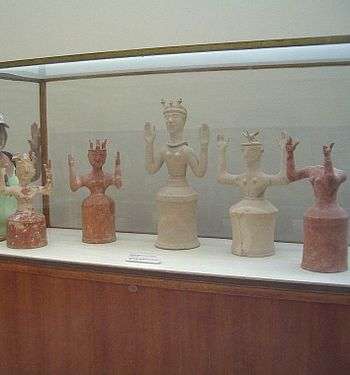Poppy goddess
The name poppy goddess is used often for a large female figurine discovered in a sanctuary of the Post-palace period (LM III, 1400–1100 BC) at Gazi, Crete. It now is in the Heraklion Archaeological Museum. The terracotta figurine has raised hands and seeds of opium poppies on her head,[1] and is believed to represent a Minoan goddess.

In this period, Mycenean influence particularly on art was strong over the island, showing that Crete had become little more than a province of the Mycenean world after the Mycenean invasion in 1450 BC. Minoan pottery figurines were found in public sanctuaries, not only in palace-sanctuaries, as is usual in earlier periods.[1] Clay figurines of the goddess with raised hands also were found in the shrine of double axes in Knossos, in Gournia, in Myrtos,[2] and also in the sanctuaries of Gortys and Prinias.[1] On the heads of the figures there are various religious symbols, such as horns of consecration, diadems, birds, and the seeds of opium poppies. The female figure known popularly as the poppy goddess is perhaps a representation of the goddess as the bringer of sleep or death.[1]
The figurines found at Gazi, which are larger than any previously produced on Minoan Crete, are rendered in an extremely stylized manner. The bodies are rigid, the skirts simple cylinders, and the poses stereotyped.
Religious significance
Interpreters speculate that the raised hands of the figurine who gazes toward the visitor indicate that it is a deity and that the gesture of the two upraised hands with open palms is an epiphany gesture of the goddess.[2] It is possible that the goddess is giving a greeting, or a blessing, or is praying, or it may symbolize her appearance in earth in human form.[1]
Poppies were mentioned in Greco-Roman myths as offerings to the dead.[3] Robert Graves believed that a second meaning of the depiction and use of poppies in the Greco-Roman myths is the symbolism of the bright scarlet colour as signifying the promise of resurrection after death [4] and that the poppy was the emblem of the goddess Demeter. According to Theocritus for the Greeks Demeter was a poppy goddess bearing sheaves and poppies in both hands (Idyll vii 157).[5]
Karl Kerenyi asserted that poppies were connected with a Cretan cult that was transmitted to the Eleusinian mysteries in Classical Greece: "It seems probable that the Great Mother Goddess who bore the names Rhea and Demeter, brought the poppy with her from her Cretan cult to Eleusis and it is almost certain that in the Cretan cult sphere opium was prepared from poppies."[6]
Fellow British classicist and scholar, Jane Ellen Harrison shares the view that the imagery of the gathered poppy reeds in the figurine's hands are associated with the Minoan/Cretan "Mother of the Gods".[7]
See also
- Demeter
- Great Goddess
- Poppy (botany)
References
- J.A. Sakellarakis. Herakleion Museum. Illustrated guide to the Museum. Ekdotike Athinon. Athens 1987. p. 91
- Walter Burkert (1985). Greek religion, Harvard University Press. pp. 23, 30
- L. Frank Baum. The Annotated wizard of Oz. p 173 ISBN 0-517-50086-8
- Robert Graves. The Greek myths. 24.15, p 96 ISBN 0-14-001026-2
- Kerenyi, 1976 p.23
- Karl Kerenyi. Dionysos. Archetypal image of Indestructible life. part I iii. The Cretan core of Dionysos myth. Princeton University Press. 1976 p. 25
- Harrison, Jane Ellen. Myths of Greece and Rome. 1928. pp. 60-61.
External links
- mekon (poppy): Theoi project